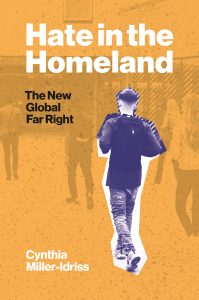In Hate in the Homeland: The New Global Far Right, Cynthia Miller-Idriss explores the places where the far right recruit young people in communities across the US and around the world. From university campuses and Mixed Martial Arts gyms to clothing stores, online forums and YouTube lifestyle channels, the book examines the physical and virtual spaces in which hate is cultivated and young people are mobilised to join violent hate groups. Katherine Williams recommends this accessible and important work to readers who want to broaden their understandings of the intersections between place, space and far-right mobilisation.
Hate in the Homeland: The New Global Far Right. Cynthia Miller-Idriss. Princeton University Press. 2020.
 Find this book (affiliate link):
Find this book (affiliate link): ![]()
Hate in the Homeland: The New Global Far Right by Cynthia Miller-Idriss lends its voice to important debates surrounding far-right mobilisation, in this case giving readers an insight into the online and offline places and spaces in which young people encounter extremist messages. The analysis offered in the book is timely; as the author outlines in the Introduction, recent hate-fuelled attacks by white supremacists in both the US and countries such as Germany, Norway and New Zealand have consolidated the growing realisation that the far right is experiencing a resurgence. The book offers readers a new way of thinking about the far right and critically interrogates the ‘imagined territories, sacred geographies, and cultural spaces’ in which the far right operates and recruits new adherents.
The six principal chapters of the book explore a range of contexts in which young people engage with the far right, reminding readers that we cannot fully understand the dynamics of this engagement without attempting to also understand the complex intersections between place, space, belonging and identity. Human beings form deep emotional attachments to places and spaces, and the far right is not exceptional in this regard. However, as Miller-Idriss points out, the ‘geographies’ of white supremacism are often entangled with deeper global and national histories of imperialism, colonialism, segregation and apartheid, as well as imbued with biological, and sometimes even ecological, essentialist notions of belonging, as the book explores.
Chapter One unpacks how the emotions and ideologies associated with particular spaces and places and the concept of a ‘Homeland’ underpin, in this context, white supremacist ideas surrounding territoriality, belonging and the construction of racialised national myths. Chapter Two demonstrates how political speech, conspiracy theories and the mainstreaming of extremist aesthetics have helped to normalise and mainstream far-right ideas. Chapter Three explores the marketisation of extremist ideas and how, for example, far-right cookery shows on YouTube are reaching diverse and receptive new audiences. Chapter Four investigates how Mixed Martial Arts (MMA) clubs have become a fertile recruiting ground: physical strength and normative masculine ideals have long been valorised by the far right.
Chapter Five explores how the far right attempts to disrupt and discredit mainstream intellectual spaces such as college campuses while simultaneously disseminating their own ideas and ideologies. Chapter Six unpacks how online spaces have been weaponised by the far right; this process continues to evolve as individuals ‘migrate’ across different platforms in response to bans, with emerging platforms broadening and deepening online forms of communication. In addition to the timely and accessible analysis presented throughout Hate in the Homeland, the in-depth bibliography will no doubt prove a comprehensive resource to readers seeking to broaden their understandings of the activities of the far right in the US and elsewhere.
A question arises: what does ‘far right’ mean, exactly? As Miller-Idriss notes, to date, no single term has captured the diverse range of ideologies at play. There remains no consensus between scholars and practitioners regarding terminology, but ‘far right’ is typically used as an umbrella term that covers both the radical right and extreme right and it remains the broadest and most practical term for the purposes of the discussion at hand. The key distinction between the ‘radical right’ and ‘extreme right’ concerns their attitude to democracy: the former tends to operate, however loosely, within democratic institutions, and the latter do not. Of course, this is an imperfect typology and somewhat oversimplified for the purpose of this review. Invariably, there are overlaps between the two and definitions can vary on a country-to-country basis, most notably in Germany where far-right groups can face monitoring by the security services if they are deemed ‘hostile’ to the constitution.
Running in parallel to this is the question of what the far right believe. Miller-Idriss outlines four overlapping categories that will help readers to make sense of the core beliefs at the heart of far-right ideology: anti-government and anti-democratic practices and ideals; exclusionary and dehumanising ideologies; existential demographic threats and dystopian conspiracy theories; and acceleration, destabilisation and apocalyptic fantasies. Knowing the difference between the extreme right and the mainstream conservative right, for example, can be a challenge, particularly given the mainstreaming of anti-government and anti-elite political rhetoric and the electoral successes of figures such as erstwhile US President Donald Trump. As Miller-Idriss explains in relation to the first category, the far right is a ‘fluid spectrum’ of groups and individuals who believe in versions of anti-government and anti-democratic ideas, practices and beliefs in more or less extreme ways. In this way, Hate in the Homeland provides readers with an accessible insight into the ideology that underpins far-right mobilisation.
Hate in the Homeland is an important contribution to our understandings of the places and spaces in which young people encounter extremist messages. The author does an excellent job of guiding readers through what can be a tricky epistemological terrain, providing a comprehensive, accessible and thoughtful overview of what the far right is, what they believe and the places and spaces they inhabit. The book will undoubtedly prove very useful to scholars working in the field as well as readers unfamiliar with the topic.
Note: This article first appeared at our sister site, LSE Review of Books. It gives the views of the author, not the position of EUROPP – European Politics and Policy or the London School of Economics.





